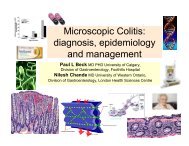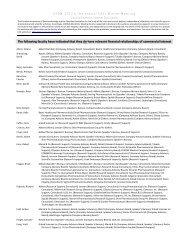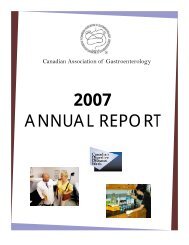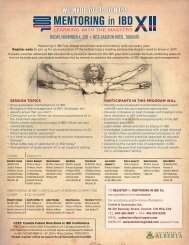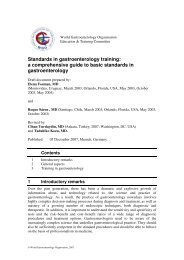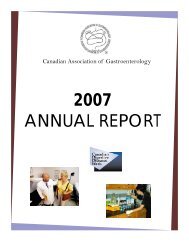Manifestations of Gastrointestinal Disease in the Child
Manifestations of Gastrointestinal Disease in the Child
Manifestations of Gastrointestinal Disease in the Child
You also want an ePaper? Increase the reach of your titles
YUMPU automatically turns print PDFs into web optimized ePapers that Google loves.
708 FIRST PRINCIPLES OF GASTROENTEROLOGY<br />
FIGURE 2. Type II failure to thrive. W refers to weight, H to height or length, HC to head circumference.<br />
factors. It is essential to beg<strong>in</strong> nutritional rehabilitation as soon as possible and<br />
not delay while wait<strong>in</strong>g for <strong>the</strong> results <strong>of</strong> any <strong>in</strong>dicated tests.<br />
History should <strong>in</strong>clude a dietary and feed<strong>in</strong>g history as well as past and<br />
current medical history. The dietary history should be as specific as possible,<br />
<strong>in</strong>clud<strong>in</strong>g quantities. For formula-fed <strong>in</strong>fants it is possible to quantify <strong>the</strong><br />
caloric <strong>in</strong>take. It is important to determ<strong>in</strong>e that formula is be<strong>in</strong>g prepared correctly.<br />
Po<strong>in</strong>ts to cover <strong>in</strong> <strong>the</strong> feed<strong>in</strong>g history <strong>in</strong>clude specifically, where, how<br />
and for how long <strong>the</strong> meals take place. Questions should be asked about<br />
whe<strong>the</strong>r <strong>the</strong> <strong>in</strong>fant coughs or chokes with feeds and whe<strong>the</strong>r <strong>the</strong>y seem to tire<br />
when feed<strong>in</strong>g. Social and family history are essential, not only because <strong>the</strong>y<br />
may have primary etiological significance, but also <strong>in</strong> order to prescribe and<br />
<strong>in</strong>stitute successful <strong>in</strong>terventions.<br />
The goals <strong>of</strong> physical exam<strong>in</strong>ation <strong>in</strong>clude:<br />
1. Assessment <strong>of</strong> <strong>the</strong> severity <strong>of</strong> malnutrition and signs <strong>of</strong> possible<br />
micronutrient deficiencies<br />
2. Identification <strong>of</strong> features suggest<strong>in</strong>g a genetic cause for growth failure









